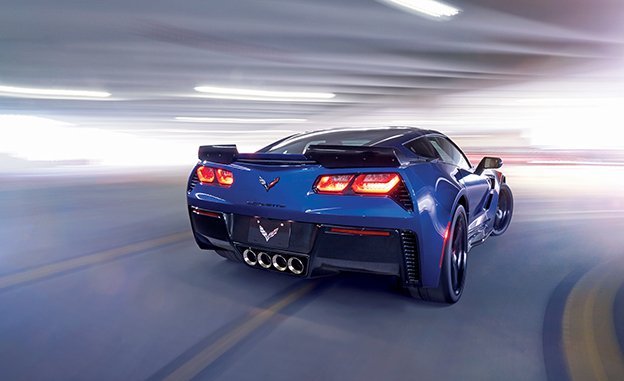From the July 2016 issue
The 2017 Chevrolet Corvette Grand Sport is probably not what you think it is.
It’s certainly not a ferocious factory racing machine, as the first blistered and vented Grand Sport was in 1963. And it’s not the wrapper in which a new version of the Chevy small-block V-8 is presented. That was true of the 1996 Grand Sport, the vehicle first to bear the LT4 engine that stoked the embers at the end of the C4’s life. One look at the new GS’s muscled glutes and you’ll know it’s something more than just a trim and paint job, but, despite the sincere wishes of some on our staff, it is not the long-awaited mid-engined Corvette.
Tadge Juechter, Corvette chief engineer and our right-seat companion for part of our first drive of the Grand Sport, puts the new car in a slightly different perspective. “This is big business for us,” he says. “The last Grand Sport [of the C6 generation] kept the Bowling Green plant running. It was our highest-volume model.”
Sports-car buyers are more fickle than most. Sales are hot when a new model arrives, as they certainly have been for the C7 Stingray, but then they typically go tumbling off a cliff after a few years. With its long history, the Corvette hasn’t necessarily suffered as much as newcomers in this cycle of boom-and-bust because enough Americans have grown up with the unwavering desire to someday buy a Corvette—not the newest sports car, but a Corvette specifically.
Still, adding a hot, updated version a couple of years into a product’s life is never a bad idea. For whatever the Grand Sport once was, it is now a full-fledged model within the Corvette lineup. And like the C6 version of the GS—as with a number of Porsche 911 variations and almost all Taco Bell menu items—the new car is an assemblage of known parts.
This particular concoction starts with the Stingray’s drivetrain, the naturally aspirated LT1 6.2-liter V-8, but fitted as standard here with the dual-mode exhaust system that’s optional on the base Stingray, plus the dry-sump arrangement of the Z51 version. It produces the same 460 horsepower at 6000 rpm and 465 pound-feet of torque at 4600 rpm. This level of output is what Rolls-Royce used to refer to, in typical winking understatement, as “adequate.”
It is only in a world where less than $100,000 can buy you a factory-warrantied 600- or 700-hp car that 460 sounds unimpressive. Have you ever tried to fully exploit 650 horsepower on the street for anything more than a fleeting moment? If so, are you currently reading this story from the comfort of the prison rec room?
As a full member of the Corvette brood, the Grand Sport is available with either the seven-speed manual or the eight-speed automatic transaxles. In the case of the manual, it carries the Z51’s shorter gearset for livelier acceleration. Opt for the automatic and Chevy specifies the Z51 automatic’s 2.73:1 final-drive ratio in place of the regular Vette’s 2.41:1 ratio.
The Grand Sport has the stance of a thick-bodied lizard and the feet of a gecko. Measuring 77.4 inches at its widest, the Grand Sport is only 3.5 inches wider than a standard Corvette, but it seems six inches . . . a foot . . . nay, a yard wider. The Grand Sport is, naturally, exactly as wide as the Z06, with which it shares its body panels and suspension setup. The sticky-footed car we drove wore track-ready Michelin Pilot Sport Cup 2 tires (P285/30ZR-19 up front and P335/25ZR-20 out back). They are part of the optional Z07 package that, as on the Z06, also comes with huge carbon-ceramic brake rotors (15.5 inches in diameter up front and 15.3 in the rear), plus the Stage 2 aero package that adds all varieties of aero doodads, fillips, and finger-noodlers.
As we approach the parked car, we notice the nearly featureless treads of the tires textured with hundreds of little white pebbles adhering to the flat surface. It looks as if the Grand Sport rides on enormous nonpareil candies. And truth be told, these tires and those candies are not the most dissimilar things in the world.
|
This GS wears the familiar red-white-and-blue get-up. But 10 body colors, six fender hash-mark hues, and five stripe options will be available. |
The suspension system is tuned to fit nicely about halfway between the Stingray and the Z06 on the passive-aggressive continuum. But each Corvette that wears the magnetorheological dampers (which come standard on the Grand Sport) has a mighty broad bandwidth of character. If you plotted the Z51, Grand Sport, and Z06 on a Venn diagram, you would find the ride and handling attributes clustered in overlapping sections. Such is the world of highly customizable, mode-shifting, electronically controlled automobilia. There’s not a bull’s-eye for ride and handling compromise. There are instead five dartboards, one for each of the distinct modes.
It’s a far cry from 1962, when Zora Arkus-Duntov developed the original Grand Sport racer on some of the same roads through GM’s Milford, Michigan, proving grounds where we’re driving the new car today. In the silent home-movie-quality footage of one of Arkus-Duntov’s drives, the father of the Corvette and two-time Le Mans class winner wears a sport coat, loafers, and a cue-ball-white open-face helmet while walking quickly to the car, a freshly lit cigarette dangling at a 45-degree angle to his face.
|
Step away from the spec charts and bench-racing arguments. The 460-hp LT1 V-8 provides more than enough power for almost everyone. |
We look nowhere near as effortlessly cool, and rain hangs in the chilly spring air, but we’re determined to make the best of it. (The unpleasant weather is why we chose to photograph the GS indoors). The 2017 car shares only its 6.2-liter engine displacement with the ’63 Grand Sport race car. But the new production car is an extremely quick machine that’s also docile and tractable in a way that would have been inconceivable in 1962. The only similarity between the two cars’ behavior is that, when wet and cold, the Cup 2 tires can’t cope with the Vette’s power—at least, not when applied liberally—and the rear of the car fires sideways. On dry pavement, these monster tires will deliver 1.20 g’s of lateral grip, says Chevy. That’s a credible claim considering that we achieved 1.19 g’s in a Z06 shod with the same tires. The standard Michelin Pilot Super Sports are much more roadworthy and long-lived and will deliver more than 1.00 g, which, let us remind you, is an enormous amount of grip that you are unlikely to exhaust on the road. You can get the standard tires by opting out of the Z07 package, which also drops the carbon-ceramic brakes for smaller cast-iron ones, the rotors of which are sized between those of the Stingray Z51 and the Z06. You might choose to forgo the carbon ceramics for price, but don’t worry about them being loud when cold or lame when wet, like some other carmakers’ carbon ceramics (we’re looking at you, BMW). These are well behaved.
Either way, Grand Sport drivers should have more than enough tire, brake, and cooling capacity for serious track work. On Milford’s ride-and-handling loop, a section of gentle curves and alternately ragged or lumpy pavement, the Grand Sport could only be made unpleasant by calling up the stiffest track setting and only then after encountering a series of chatter bumps. You won’t do that. Left in touring or sport, the ride is admirably free of harshness and the car shrugs off nasty midcorner heaves and hillocks. As with other Corvettes, you can also personalize the settings for various systems to suit your fancy. The tuning of the dual-mode exhaust is coordinated with each mode—almost mute in eco mode and getting fairly nasty in sport and track. By modifying the threshold at which the exhaust’s butterfly valves open, Chevrolet has made the Grand Sport a little more aggressive than the standard Stingray, according to Charlie Rusher, a noise and vibration engineer on the Corvette. If you’re looking for someone to thank for the pitch-perfect rumble/rip of the Corvette’s exhaust, Rusher would be a good candidate.
|
The GS’s Z07 package comes with the Stage 2 aero kit. The Stage 3, with its clear, adjustable wickerbill, was deemed too extreme for the model. |
With greater aerodynamic drag than a Stingray, the Grand Sport will lose a couple of mph from the base car’s 181-mph top speed, says Juechter. The Grand Sport weighs an estimated 130 pounds more than the Stingray (for a total claimed weight of 3428 pounds). Still, Chevrolet figures an automatic Grand Sport with the Z07 package will get to 60 mph about a tenth quicker than a Stingray automatic because of the increased rear traction.
Otherwise, the Grand Sport feels like what it is: a Stingray with an enormous amount of grip. And it looks like what it is: a Z06 without the completely absurd power. At $66,445, the base price of the Grand Sport coupe is about $10,000 higher than an entry-level Stingray, roughly $5000 more than the cheapest Stingray Z51, and about $15,000 less than the least expensive Z06. The convertible Grand Sport starts at $70,445. This is the sweet spot, folks.
At those prices, with that look, expect that the Grand Sport will once again be big business for Chevrolet.
Powered by WPeMatico









